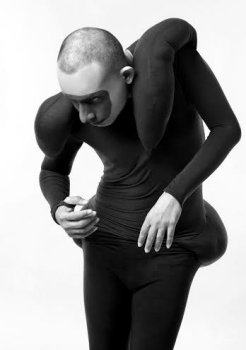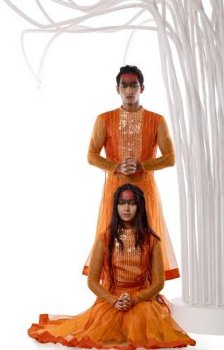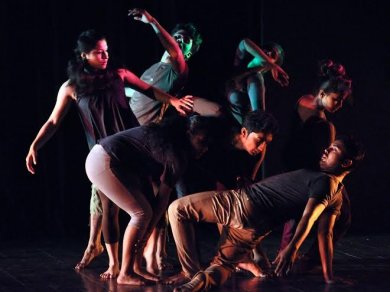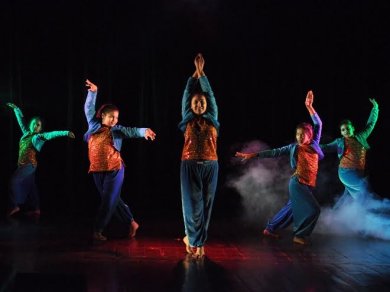
|   |

|   |
New works by Rhythmosaic-Sengupta Dance Co and Sapphire Creations - Sulagna Mukhopadhyay e-mail: sulagna64@gmail.com March 24, 2014 A slight stooping figure dressed in grey appears on the stage, while a few assemble around a tree, the tree of aspiration and stretch out their hands toward the top of the tree. The background music is quite monotonous. Besides the monotony of the music, the figure also repeats his movements again and again. It is perhaps to project the inner emotions of the character, Barbareek. The piece named Barbareek - The Indestructible explores the precise state of human consciousness. According to the myth, Barbareek was the son of Ghatotkacha. He was beheaded but his head was placed on top of the mountain in order to witness all the sequences of the Kurukshetra war. Ronnie Shambik Ghosh plays the character of Barbareek and he is quite convincing.  Barbareek  Aravan with his mother Ulupi From Barbareek, the choreographers move to depicting the character of Arjuna, who is known to his readers for his valour. But as a human being, this character also has its darker sides like selfishness, treachery, which we tend to forget. His relationship to Ulupi, the Naga princess from Manipur, establishes the pain and agony in any such relationship, where the female gender is dumped by the man after he achieves his fulfillment in life. According to a version of the epic, Arjuna met Ulupi during his years of Vanaprastha (banishment) and enjoyed a night of conjugal bliss and then Arjuna went his way, rejecting any commitment to Ulupi. In the process, Ulupi’s self esteem and dignity were shattered. As most men would do, this mythological character Arjuna also cited Hindu philosophy as example to get rid of Ulupi. Ulupi symbolized one-sided unconditional commitment and the disappointment of unfulfilled hopes and aspirations. Aravan, the son born out of their wedlock, grew up without any relationship with his father (Arjuna) and was doomed to being ‘the desolate son.’ Destiny demanded the sacrifice of one from Arjuna’s bloodline, in order to ensure that his bravery triumphed at Kurukshetra. Aravan sacrificed his life. Mitul Sengupta as Ulupi and Yorma Loringett as Arjuna are befitting. One could notice the magical shift of the dancer Mitul from the unfettered ebullience of pure dance to expressional dance pattern. Prasanna Saikia as Aravan, the metaphor also needs special mention. The costumes designed by Swarup Dutta, Debby Nath Germanotta and Manju Agarwal made the production more effective. Music was scored by Dishari Chakraborty, Bernard Dsouza, Munnu Shaw and Biswajit Pal. This Indo-French presentation of Rhythmosaic-Sengupta Dance Company (India) and Offjazz Dance Company (France) titled ‘Buddha - The Why Within’ was staged on March 2, 2014 at G.D. Birla Sabhaghar, Kolkata. The choreographers were Gianin Loringett, Martine Kaisserlian, Ronnie Shambik Ghosh and Dr. Mitul Sengupta. Though the production is certainly striking, it would be nice if the choreographers clear the doubt about their production being named after Buddha, while all prophets across time had the same philosophical visions. Sudarshan Chakravorty’s passion for the modern dance form, various new endeavours and the ability to spot young talents keep the company going in Kolkata’s contemporary dance movement. On March 11, 2014 the connoisseurs of modern dance witnessed a production by JS Wong (Malaysia), who was here in Kolkata for two weeks conducting a workshop with students of the company. It is a part of Sapphire’s ongoing project Showcase of International Choreographers’ Residency INCRES X. The program staged at the auditorium of Goethe Institut, Max Mueller Bhavan, was inaugurated by its director Mr. Friso Maecker. The program began with Pronam (invocation) by about thirteen children aged between 4 and 13 years. This number was followed Pom Pom inspired by Afro-Jazz and Caribbean Music. The other two were Papa loves Mambo by Perry Como and a mystical piece on enchanting Arabian music. The group was trained by Anubhav Duttagupta, a member of the company. The second item was the best of all. It was an eclectic and enticing mixture, one that very much reflects the influence of workshops on various western dance forms. The Mambo number despite its charismatic lyrics and music was not that enthralling. It would have been perhaps more eye-catching, if the dancers danced in pairs  I-Identity, Inspiration, India  The Playgroup Being the artistic director and in-house choreographer of Damansara Performing Arts Centre, Malaysia, JS Wong has many feathers in his cap. 'I-Identity, Inspiration, India...' was conceptualized by Wong during his stay in this city. He began by collecting sounds, images and characters from the city and people living around him. He was flabbergasted by the cacophony of horns of the Kolkata traffic. He observed that a car lane can fit in here two vehicles and pedestrians simultaneously. This intimate distance captured his attention and Wong examined the idea of distance within his choreography. In brief, the choreographer wanted to showcase his impression about India, the country along with her inhabitants and in the process he continually questioned his own identity. The curtain rose with honking sounds of vehicles and people commuting on the street, each trying every way to surpass the other in front, followed by fast numbers and a German poem. It would have been better, if the name and the author of the poem were mentioned on the leaflet distributed to the audience. The poem, however, echoed the theme of the production: Die nächste Antwort ist die nächste Frage der Menschen (The following answer leads the way to another question). The dancers stomped their feet in perfect unison. There were also moments of hyper-slow movements peppered with bursts of frenzied and often martial fury. Dibyendu Nath created some delightful moments with his conjuring activities. Veteran dancers like Paramita Saha, Ankita Duttagupta, Koushik Das, Pintu Das, Rahul Deb Saha and Dibyendu Nath have worked in perfect combination with younger ones like Rima Halder, Sriparna Mitra, Sayantani Mukherjee and Amit Adhikari. Sulagna Mukhopadhyay was trained in Bharatanatyam by Guru Thankamani Kutty and Indian folk by Late Botu Pal. She has an M.A. in Comparative Literature and has freelanced for various leading newspapers of Kolkata like The Telegraph, The Statesman and Ananda Bazar Patrika. She has written articles on dance and gender issues. She is a teacher of South Point School since 1996. |